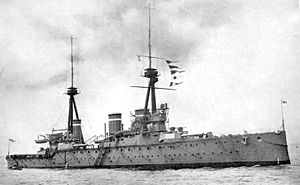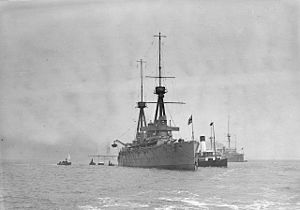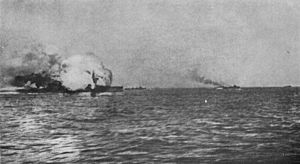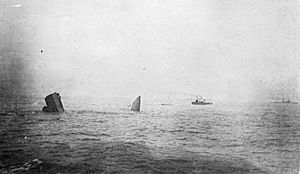HMS Invincible (1907) facts for kids
 |
|
Quick facts for kids History |
|
|---|---|
| Name | Invincible |
| Ordered | 1906 Naval Programme |
| Builder | Armstrong Whitworth |
| Laid down | 2 April 1906 |
| Launched | 13 April 1907 |
| Commissioned | 20 March 1909 |
| Fate | Sunk, 31 May 1916, during the Battle of Jutland |
| General characteristics | |
| Class and type | Invincible-class battlecruiser |
| Displacement | |
| Length | 567 ft (173 m) overall |
| Beam | 78 ft 6 in (23.93 m) |
| Draught | 30 ft (9.1 m) deep load |
| Installed power | |
| Propulsion | 4 × shafts; 2 × Direct-drive steam turbine sets |
| Speed | 25.5 knots (47.2 km/h; 29.3 mph) |
| Range | 3,090 nmi (5,720 km; 3,560 mi) at 10 knots (19 km/h; 12 mph) |
| Complement | 784 (up to 1000 in wartime) |
| Armament |
|
| Armour |
|
HMS Invincible was a very important warship built for the Royal Navy in the early 1900s. She was the first ship of her kind, called a battlecruiser. This new type of ship was designed to be as fast as a cruiser but with the heavy guns of a battleship.
During World War I, Invincible played a role in several major battles. She fought in the Battle of Heligoland Bight and, more famously, helped sink two German ships at the Battle of the Falkland Islands. Sadly, she was destroyed during the huge Battle of Jutland in 1916 when her armour was hit, causing an explosion.
Contents
About the Invincible
Invincible was much bigger than earlier armoured cruisers. She was about 567 ft (173 m) long, which is longer than two football fields! She was designed to be very fast for her size.
The Invincible-class ships were first called armoured cruisers. But in 1911, they were officially renamed "battlecruisers." This new name showed they were a mix of a fast cruiser and a powerful battleship.
How the Ship Moved
Invincible had two sets of steam turbine engines. These engines were powered by 31 large boilers. They were designed to produce a lot of power, allowing the ship to reach speeds of over 25 knots (46 km/h) (about 46 km/h). This made her one of the fastest warships of her time.
The ship carried a lot of coal and some fuel oil. This fuel allowed her to travel for about 3,090 nautical miles (5,720 km) (about 5,723 km) at a speed of 10 knots (19 km/h) (about 18.5 km/h).
Ship's Weapons
Invincible had eight large 12-inch (305 mm) guns. These were placed in four turrets, with two guns in each. At first, these turrets had problems with their electrical systems. They were later changed to work with hydraulic power, which was much more reliable.
She also had sixteen smaller 4-inch (102 mm) guns. These were used against smaller ships. Later, some of these guns were moved and given shields to protect the crew better. For defence against aircraft, she had a few anti-aircraft guns. The ship also carried five torpedo tubes, which could launch torpedoes underwater.
Ship's Protection
The Invincible had strong armour to protect it from enemy fire.
- Her main side armour, called the belt, was about 4 to 6 inches thick.
- The gun turrets and the areas below them (barbettes) had 7 inches of armour.
- The decks had armour between 1 and 2.5 inches thick.
- There were also special torpedo bulkheads, 2.5 inches thick, to protect the ammunition rooms (magazines) from torpedo hits.
Building and Service
Invincible was built at the Armstrong Whitworth shipyard in England. Her construction started on 2 April 1906, and she was launched on 13 April 1907. While still being built, she was hit by another ship, but the damage was repaired. She was officially finished on 16 March 1909.
After being commissioned, she joined the 1st Cruiser Squadron. She took part in several fleet exercises and reviews. Her gun turrets continued to have problems, and it took several years and refits to fix them. In 1913, she was sent to join the Mediterranean Fleet. She returned to the UK in late 1913 for a big repair that finally fixed her turrets.
First World War Battles
Her major repairs were stopped when World War I began on 4 August 1914. Invincible was quickly made ready for action. She was the first battlecruiser to get a new fire-control system, but it wasn't fully working yet.
Battle of Heligoland Bight
Invincible first saw action in the Battle of Heligoland Bight on 28 August 1914. She was part of a battlecruiser force led by Admiral Beatty. Their job was to support smaller British ships near the German coast. During the battle, Invincible helped sink the German light cruiser Cöln. She also helped destroy the older light cruiser Ariadne.
Battle of the Falklands
In November 1914, a German squadron had destroyed a British squadron at the Battle of Coronel. To get revenge, the British sent Invincible and her sister ship Inflexible to find and destroy the German ships. These two battlecruisers, commanded by Doveton Sturdee, arrived at the Falkland Islands on 7 December.
The German ships, led by Maximilian von Spee, arrived at the Falklands on 8 December, planning to attack a radio station. They were surprised to find the British battlecruisers there. The British ships were much faster and had more powerful guns.
The British ships chased the Germans. Invincible and Inflexible opened fire from a long distance. The German ships tried to escape, but the British battlecruisers were too fast. The battle lasted for hours. Invincible and Inflexible hit the German armoured cruisers Scharnhorst and Gneisenau many times. Scharnhorst sank first, and then Gneisenau was also destroyed.
Invincible was hit 22 times during the battle, but the damage was not serious, and only one person on the British battlecruisers was killed. After the battle, Invincible went for repairs and then joined the Grand Fleet in England.
Battle of Jutland
In May 1916, Invincible was part of the 3rd Battlecruiser Squadron, led by Horace Hood. This squadron was temporarily with the Grand Fleet for gunnery practice. On 30 May, the entire Grand Fleet went to sea because German ships were spotted.
On 31 May, Invincible received messages about enemy ships. Hood's squadron sped up to meet the German fleet. Invincible and her sister ships engaged German light cruisers, driving them away. Later, they joined the main battle between the British and German battlecruisers.
At about 18:21, Invincible and the other battlecruisers opened fire on the German flagship Lützow and Derfflinger. Invincible hit Lützow twice below the waterline, which eventually caused her to sink.
However, at 18:30, Invincible became a clear target for the German ships. Lützow and Derfflinger fired at her. Within 90 seconds, Invincible was hit by a large shell in her midships 'Q' turret. This hit caused a massive explosion in her ammunition magazines, blowing the ship in half.
Out of 1,026 officers and men on board, 1,020 were killed, including Rear-Admiral Hood. Only six people survived the explosion.
Wreck Site
After the war, the wreck of Invincible was found lying on the seabed at a depth of 180 feet (55 m). The ship is broken into two main parts: the stern (back) is upright, and the bow (front) is upside down.
Divers have explored the wreck. They found that the large 12-inch guns in the back turret were still loaded, but the roof of that turret was missing. This suggests that the explosion that destroyed the ship was very powerful.
The wreck of Invincible is now a protected site under a special law in the UK. This means it is treated as a war grave and cannot be disturbed. A mountain in the Canadian Rockies was named Mount Invincible in honour of the battlecruiser in 1917.
Images for kids
See also
 In Spanish: HMS Invincible (1907) para niños
In Spanish: HMS Invincible (1907) para niños






